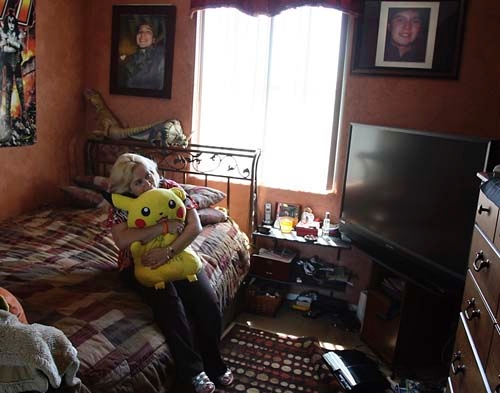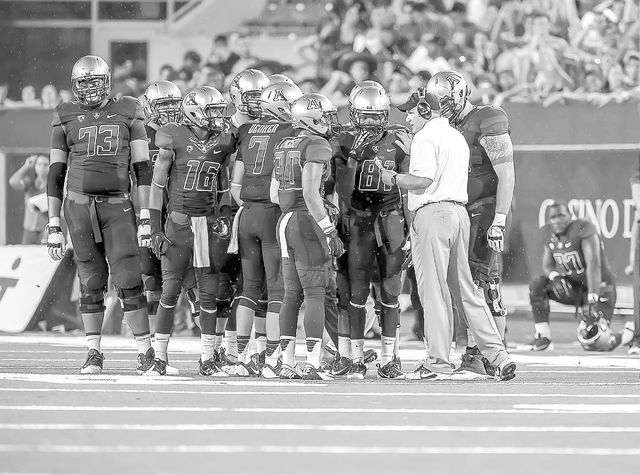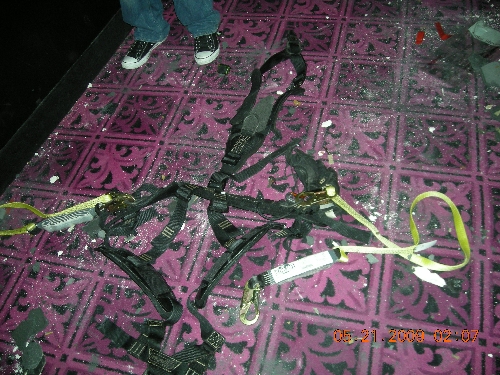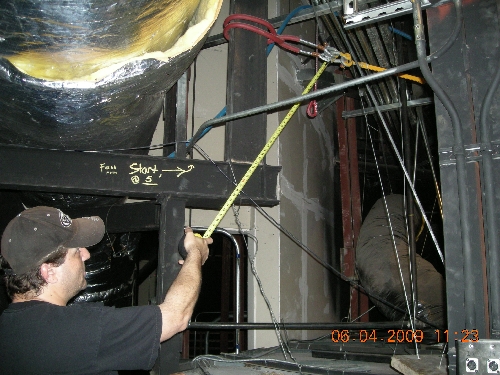Family remembers worker as officials close files on fatal fall
"Drive safe," were the last words Marychris Rodriguez ever spoke to Vicente, her 20-year-old son. That was as he headed to a one-night stage job on the Strip to help "load out" the Tom Jones show, which had finished its run at a local hotel.
Vicente never returned.
His ashes, wrapped in one of his favorite T-shirts, now take a place of honor in a nook of the Rodriguez living room.
That night -- May 20, 2009 -- Vicente Rodriguez fell 37 feet to his death on the floor of the Hollywood Theater, inside the MGM Grand. He died trying to do the job of a high rigger, risky work for which he had received little training.
A high rigger climbs to the rafters of a hall or arena to move around lighting, cables and scenery. But Rodriguez had signed on with Rhino Las Vegas, a staging contractor, solely for ground rigging, which entails moving and packing equipment at the theater's ground level. Ground riggers earn less than high riggers.
Rodriguez and two other Rhino newcomers were supposed to be excluded from high rigging work , according to an e-mail to the company, written by one of their parents a month before Rodriguez's death.
Adding to the anguish of losing Vicente, his mother says no one -- not the hotel, not the subcontractor Rhino, not even the state's workplace safety agency -- has explained to her, after more than a year, "why the hell" his Rhino supervisor, or the hotel rigger in charge of the theater that night, told the inexperienced young man to go up high.
The Nevada Occupational Safety and Health Administration, the hotel and the rigging company have all closed their files on the case. Not the Rodriguezes.
WAKING TO A NIGHTMARE
Rodriguez fell at 10:22 p.m., according to OSHA records. He was pronounced dead, of a snapped neck, at University Medical Center's trauma unit, at 10:52 p.m.
When family members woke up Marychris Rodriguez after 3 a.m. to give her the news, she remembers thinking, "I didn't send him to war. He wasn't a bullfighter. He wasn't a policeman, with a gun, chasing the bad guys."
Neither the contractor nor the hotel had notified the family of their son's death.
Relatives learned of it as word spread by cell phone among stage workers along the Strip.
The UNLV freshman had taken the Rhino job on his night off from "Le Reve" at Wynn Las Vegas, where he had been working regularly as a ground rigger. He had celebrated his 20th birthday only five days before.
He knew well the difference between low and high rigging, his mother says, as the extended family has many circus performers and stage workers.
She had spent her own young adult years touring with the family's aerial act.
But Vicente looked at rigging as a job that could put him through college, where he had hoped to major in business. He had four relatives in town who were high riggers, who were going to start training him to go high once he turned 21.
THE ACCIDENT
The coroner's report bluntly details the sequence of Vicente Rodriguez's final acts.
The hotel's supervising rigger led the novice up over the stage, above a false ceiling, to a dusty space where planks only 9 inches wide served as walkways.
The two were going to pull out a large sound cable that belonged to the exiting Tom Jones show.
The rigger told Rodriguez where to hook his harness for safety.
Then the veteran "turned his back on the decedent to move forward, and all at once he (the veteran) heard a loud noise. When he turned around, there was a large hole (in the false ceiling) ... where the decedent would have been."
The lethal bottom line: Rodriguez tried to balance on a catwalk railing to clip onto a "lifeline" overhead, but slipped. He tumbled off the rail, then through a false ceiling, then almost 40 feet to the hot pink carpeting of the empty showroom.
There he lay as workers rendered first aid -- though no one detected breathing or a pulse -- until paramedics arrived to take him to a hospital.
ACCIDENT'S AFTERMATH
Over time, the Rodriguez family's hell has expanded.
Police never went to the scene. Though witnesses told OSHA they phoned 911, emergency dispatch records show only a 311 call -- designed for lesser emergencies -- at 10:51 p.m.
Curiously, it appears the ambulance transported Rodriguez well before the 311 call, since he was pronounced dead at UMC one minute later, according to his death certificate.
Most galling to the Rodriguezes is that Rhino and MGM Grand paid minimal fines for serious safety violations OSHA documented at the accident scene.
"My son is worth a Kia?" is Marychris' summation of Rhino's $4,000 OSHA penalty for unsafe conditions and practices related to the accident.
The host property, MGM Grand, paid a $19,800 penalty.
Both companies knocked down their violation count, and dollar amount, via negotiation. The MGM Grand went from seven violations to four; Rhino went from eight to two.
A state OSHA review board approved both adjustments, with the Rhino settlement just formalized in June.
Twice Marychris Rodriguez has hired an attorney to pursue a wrongful death lawsuit, only to be dropped as a client. Both lawyers cited Nevada's workers' compensation law, which prohibits such lawsuits -- even if willful negligence by an employer can be demonstrated -- as long as the employer belongs to the workers' compensation program.
"I feel like I'm toxic," the mother says of the legal impasse.
The family wants justice, which Marychris defines as a substantial consequence for the parties to whom they entrusted their son's life.
To date, the family has refused to accept a workers' compensation check from the state for Vicente's job-related death. For a Nevadan with no dependents, the amount covers burial expenses, up to $10,000, plus the cost of transporting remains.
HOTEL, SUBCONTRACTORS WON'T TALK
Rhino Las Vegas and MGM Resorts International, which is the hotel's parent company, both declined to discuss with the Review-Journal the stack of papers documenting Nevada OSHA's investigation into the accident. Both declined to answer questions.
MGM spokesman Alan Feldman responded to an interview request in writing: "Our deepest sympathies are with the family of Vicente Rodriguez due to the tragic circumstances that resulted in his death." He also wrote that, "We cooperate with, and assisted OSHA fully in its investigation of the incident, made physical enhancements to the theater, and paid in full the fines that were levied."
Jeff Giek , Rhino's president, told the newspaper by phone, "I've been instructed by my counsel, due to the pending nature of the litigation in this matter, not to speak to you."
OSHA records show multiple factors contributed to Rodriguez's demise.
Someone loaned him a harness, but no one noticed he had no safety line hooked into the single harness loop that's specifically designed to arrest a fall.
Two other secondary lines, or "lanyards," on the side of his harness were not the proper type.
Plus, neither of those lanyards was attached to a fixed object when the 20-year-old tried to balance on a catwalk railing to reach the overhead lifeline that was supposed to save him from a fall. According to the supervisor's OSHA statement, he turned away after giving Rodriguez the clip-in instructions.
Rodriguez climbed onto the rail because a man of average height could not reach the lifeline while standing on the catwalk floor, according to OSHA records.
Other Rhino riggers also gave statements that they, too, used the same "precarious approach" (OSHA's report terminology) to reach the line above. But, experienced riggers knew to clip in somewhere, even to the rail itself, before climbing up.
As Rodriguez fell, he may have brushed a suspended plank that was hanging in arm's reach. It was the very plank he was supposed to step on next. But unlike a permanent work platform, the plank lacked any rail for a flailing person to grab onto, photos show.
WHAT OSHA COULD HAVE DONE
Were those planks a temporary scaffold or were they a permanent work platform?
MGM Grand had it both ways, according to two OSHA reports.
In a routine inspection of the entire hotel in early 2009 -- three months before the fatal accident -- an inspector at the Hollywood Theater spotted the suspended planking. According to OSHA chief Steve Coffield, when the inspector asked its purpose, a hotel representative told her the boards went up for the theater's construction in 1994 and never came down, but were not in use.
In effect, the MGM Grand maintained the boards were temporary scaffolding that had been abandoned "in place." As a result, the inspector did not check the planks, nor the access route to the planks.
But after the fatality, when OSHA tried to cite the parties for unsafe temporary scaffolding, they successfully argued in negotiations that the planks were not temporary, as workers had installed them in 1998, not 1994. (A citation for the planks as a hazardous work platform did stick, however.)
After the accident, a longtime Rhino worker told OSHA that riggers had been using the "abandoned" planking for about six years, as long as Tom Jones had been using his own sound cable for engagements in the theater.
The singer has performed there close to quarterly, according to OSHA witness statements, which totals about 24 runs over six years. That means riggers used an unsafe route to access the unsafe planking at least 48 times, to install cable before the first show and remove it after the last. Records also say workers went on the planks to change out ceiling light bulbs.
The conflicting statements by MGM Grand -- as to whether the planking truly was abandoned -- could be construed as "bad faith." Bad faith is one of the factors allowing OSHA to cite safety violations individually, instead of its usual practice, which is to bundle them by category.
Citing violations individually is more costly to an employer, as each violation incurs a separate financial penalty. The item-by-item option is reserved for egregious workplace accidents.
The Review-Journal asked Nevada OSHA officials why they did not exercise the item-by-item option for calculating fines. Coffield said his investigative staff did not see bad faith or gross negligence on the part of MGM Grand or Rhino.
Investigators "focused on the (fatal) incident that evening, and went forward from there," Coffield said. "We're addressing the issues that caused the accident."
He called it "not reasonable" for inspectors to draw links between the new accident and the prior inspection, since the hotel had not been cited previously for the planking.
THE NEXT PHASE
A year and two months have passed since Rodriguez fell. What is different at the place where he worked and died?
MGM Grand has removed the planking above the showroom. It also has devised an alternate way to snake sound cables in and out, so riggers now do it standing on the existing catwalks.
But, Vicente's mother's heart still aches. To Marychris Rodriguez the showroom's improvements and the hotel's low OSHA fine are "a Band-Aid solution by a billion-dollar corporation."
She e-mailed David Michaels, the head of federal OSHA, in March to complain Nevada OSHA's investigation was inadequate.
In part, she wrote, "When an (industry) owns half the town and employs most of it, the question does hang in the air like dirty laundry -- how much does OSHA let the Casinos get away with?"
In April, Marychris Rodriguez received word federal OSHA was investigating the state investigation.
Recently, Nevada OSHA's Coffield confirmed this by saying, "We await the findings."
Contact reporter Joan Whitely at jwhitely@reviewjournal.com or 702-383-0268.
WATCH THE VIDEO: Death in a Showroom Conceptual graphic of events RELATED STORIES: • Employers may face higher penalties • Las Vegas the US Capital of Rigging





















